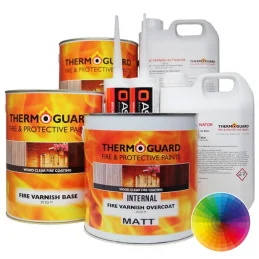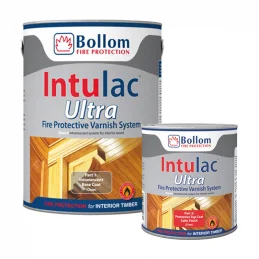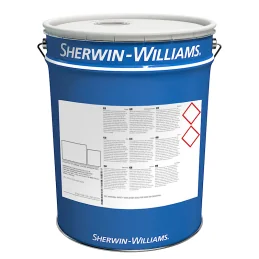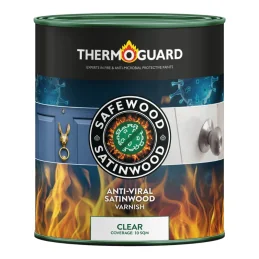- There are no more items in your cart
- Shipping Calculated at checkout
- Sub-Total (inc. VAT) £0.00
Need Help?
Fire Retardant Varnish
Fire retardant varnishes for wood and timber, are clear protective coatings which protect and beautify the natural appearance of the surface. Now available in wood stain colours as well, they are ideal for fireproofing any size area of exposed wood beams, boards, MDF, veneer, etc. Click here if you require coloured fire-retardant paints for wood and timber, or alternately shop for intumescent paints for interior and exterior wood and timber in clear or coloured finishes.

Thermoguard Fire Varnish BS Class 1/0 & EN Class B System
A clear fire retardant varnish for interior and exterior timber surfaces. Important!For use on timber with a minimum thickness of 9mm. Woodstains are only available on the following shipping options:Express: 1-3 Working Days Delivery (Thermoguard DS) Economy: 7-10 Working Days Nationwide DeliverySee further below for...

Thermoguard Fire Varnish 30 & 60 Minute System
A clear intumescent varnish (with 9 woodstain shades available) for interior and exterior timber surfaces. Each pack contains the correct amount of basecoat (Fire Varnish Basecoat) and topcoat (Thermoguard Fire Varnish Overcoat (Interior) or Thermoguard Fire Varnish Overcoat (Exterior)) to ensure protection is achieved inline with the...

Thermoguard Fire Varnish Door Upgrade System
An intumescent varnish system to upgrade solid doors to 20 or 30min Fire Resistance:Available as a convenient pack containing the required basecoat, topcoat and mastic to protect 3 doors in a clear or woodstain coloured Matt or Satin finish Thermoguard UK will issue a Fire Certificate for Authority approved projects following completion...

Bollom Intulac Ultra BS Class 0 Kit
Clear, fire-retardant varnish system that provides sufficient intumescent basecoat (Bollom Intulac Ultra Basecoat) and topcoat (Bollom Intulac Ultra Topcoat) to protect bare or previously varnished* interior timber surfaces** to BS Class 0. *Maximum of four, single, well-adhered coats. **Not suitable for surfaces exposed to mechanical stress...

Intercoat Irufire Real B-S2 D0 PUR IC130
A two-pack clear acrylic-aliphatic coating in 4,000+ colours. Developed to finish wood surfaces classified as D-s2,d0 according to UNE-EN 13238 and must accomplish the UNE-EN 13823:2012 norm of Reaction to fire (SBI test) and later classification according UNE-EN 13501-2007 + A1:2010 (Euroclasses).Part of the Irufire range For...

Intercoat Irufire B-s1 d0 PUR Primer IC120
A varnishing process with 4,000+ colour options comprising a basecoat (Irufire B-s1, d0 PUR Primer) and a topcoat (Irufire B-s1, d0 PUR Topcoat). Both products are bicomponent based on acrylic resin.Formulated for finishing wood surfaces classified as B-s1, d0 which have to comply with the UNE-EN-13.823:2002 standard for reaction to fire...

Intercoat Irufire Catalyst IC212
Catalyst for use with various industrial Intercoat wood products. Not to be used as a standalone item. Product is the catalyst for the Intercoat Irufire range.For professional use only.

Intercoat Irufire B-s1 d0 Topcoat IC123
A varnishing process in 4,000+ satin colours comprising a basecoat (Irufire B-s1, d0 PUR Primer) and a topcoat (Irufire B-s1, d0 PUR Topcoat), bicomponent based on acrylic resin.Formulated for finishing wood surfaces classified as B-s1, d0 which have to comply with the UNE-EN-13.823:2002 standard for reaction to fire and classification...

Thermoguard Fire Varnish Overcoat (Exterior)
A clear/wood stain-coloured decorative lacquer for use over Thermoguard Fire Varnish Basecoat for exterior surfaces.Each 20m2 pack of Thermoguard Fire Varnish Exterior Overcoat is sufficient to apply the required 2 coats to 20m2 of surface area.Important!Restricted to professional users. Not for sale to, or use by the general...

Thermoguard Fire Varnish Overcoat (Interior)
For use in combination with and over Thermoguard Fire Varnish Basecoat in internal applications - available in clear and a choice of woodstain colours.For timber/timber derived substrates Clear, UV and wear-resistant finish Certificate of Supply available when used over Thermoguard Fire Varnish BasecoatImportant!Woodstains are...

Bollom Intulac Ultra Basecoat
A clear, high-performance fire protection varnish coating for interior wood surfaces.Can be applied over existing varnish Simple 3 coat system to achieve Class 0 Single pack products Protects and highlights natural beauty of the wood Diminishes flue-gas density/temperature Insulates against heatMore Info View Similar Products...

Sherwin-Williams Pyroplast Wood T
A single component water-based fire protective coating system for use on most interior soft and hardwoods, including plywood, chipboard, fibre insulation board, hardboard and veneering.. Pyroplast Wood T emphasizes the interior design of timber structures in keeping an attractive option to architects, builders and end-users. Insulates against...

Sherwin-Williams Pyroplast Wood Top T
A single component water-based topcoat for use with Sherwin-Williams Pyroplast Wood T for fire protection coatings on most soft and hardwoods, including plywood, chipboard, fibre insulation board, hardboard and veneering, . Pyroplast Wood T is a single component water-based fire protective coating system for use on interior wood surfaces....

Thermoguard Fire Varnish Basecoat
A clear intumescent varnish that is the first coat of a 2 coat system (3 coats externally) for the decorative Fire Protection of timber and timber derived substrates to BS Class 1, Class 0 and EN Class B s2 d0. See Thermoguard Fire Varnish Overcoat (Interior) or Thermoguard Fire Varnish Overcoat (Exterior) to complete the system. Complete...

Bollom Intulac Ultra Topcoat
High performance decorative varnish system that delivers excellent clear fire protection to interior wood and timber.To be applied over Bollom Intulac Ultra Basecoat to complete a Class 0 fire-rated system Certificates of conformance & installation available Single pack

Tikkurila Akvilac WF 10
Single-pack water-borne lacquer used together with Fontefire WF Clear provides the B-s1, d0 classification.Chemical-resistant top lacquer for fire-retardant interior lacquer systems. Extends the usage area of fire-retardant lacquer by providing resistance to the most used household chemicals. Levels evenly and smoothly on top of...

Tikkurila Fontefire WF Clear
A water-borne intumescent coating with highest possible fire retardant properties on interior and exterior wood. When subjected to heat, Fontefire WF Clear expands and forms an insulating layer of foam.Fontefire WF Clear has fire reaction class B-s1, d0, according to the standard EN 13501-1:2007+A1:2009, the highest possible for wood...

Thermoguard Safewood Satinwood Anti-Viral Varnish
A decorative and protective clear satin finish applied over Safewood systems and Thermoguard Fire Varnish Basecoat. For the Matt version see Mattwood Varnish. Unless protected with a treatment to kill enveloped coronaviruses, flu and bacteria, hand contact with doors, frames, window sills and other wood create a potential infection risk....

Thermoguard Safewood Mattwood Anti-Viral Varnish
A decorative and protective clear matt finish applied over Safewood systems and Thermoguard Fire Varnish Basecoat. For the Satin version see Satinwood Anti-Viral Varnish. Unless protected with a treatment to kill enveloped coronaviruses, flu and bacteria, hand contact with doors, frames, window sills and other wood create a potential...
Need Help?
Need Help?
Fire retardant varnishes are surface treatments applied to materials, primarily wood, to reduce their flammability and inhibit the spread of fire. These varnishes enhance the fire performance of the substrate they are applied to, contributing to passive fire protection measures within buildings. Proper application and adherence to testing standards are essential to ensure these treatments provide the intended level of protection in building structures.
Types of Fire Retardant Varnishes
Fire retardant varnishes are used to enhance the fire safety of various materials, primarily wood and wood-based derivatives, in the construction of buildings. These varnishes are surface film-build coatings and treatments, which differ from penetrative impregnations which are not film-building. Here’s an overview of each type:
Key Aspects of Surface Coatings
Surface coatings are applied to the exterior of the wood and can be implemented either off-site under factory conditions or on-site. There are two main types of surface coatings:
Intumescent Coatings:
Mechanism:
When exposed to fire, these coatings swell to form a thick, insulating char layer. This layer protects the underlying material from heat and oxygen, slowing down combustion.
Application:
They can be applied to a variety of substrates, including wood and wood-based products. Intumescent coatings are sensitive to moisture, so they must be carefully chosen based on the environmental conditions.
Ablative Coatings:
Mechanism:
These coatings release gases or vapours that interfere with the chemical reactions in flames, effectively reducing fire spread.
Application:
Suitable for surfaces that need a protective layer to hinder flame spread and reduce heat release.
Performance Considerations for Fire Retardant Varnish
The performance of fire retardant varnishes is influenced by several key factors, which are essential for ensuring the effectiveness of the treatment in enhancing fire resistance.
Substrate Interaction
The effectiveness of a fire retardant varnish is highly dependent on the type of substrate it is applied to. Different materials will interact with the varnish in unique ways, affecting the overall fire performance. For instance:
- Hardwoods generally achieve better fire performance than softwoods due to their denser structure.
- Softwoods may require more robust fire retardant treatments to achieve similar levels of fire resistance as hardwoods.
Application Method and Conditions
Proper application is crucial for the performance of fire retardant varnishes. The following considerations must be adhered to:
Surface Preparation:
Surfaces must be free from dirt, dust, wax, grease, oils, visible moisture, and previous film-forming coatings to ensure the varnish adheres properly.
Application Environment:
Attention must be paid to air and substrate temperatures, as well as relative humidity, during application. These factors should fall within the manufacturer’s specified parameters to ensure proper curing and effectiveness of the varnish.
Application Techniques:
Varnishes can be applied using brushes, rollers, or sprays. It is essential to achieve the correct 'loadings' of the coating, which may require multiple coats. Inadequate application can reduce the efficiency of the varnish and invalidate the manufacturer’s performance claims.
Reaction to Fire
The term 'reaction to fire' refers to how a construction product behaves when exposed to fire, including its propensity to ignite, spread flames, release heat, and produce smoke. Fire retardant varnishes aim to enhance these properties to prevent the rapid growth and spread of fire:
Spread of Flame:
This measures how far and fast flames can spread across the surface of the treated material. Varnishes applied to surfaces with lower natural flame spread characteristics will generally perform better.
Heat Release:
This indicates the amount of heat a product contributes to a fire's growth. Fire retardant varnishes aim to minimise this contribution, especially in critical areas like escape routes and public buildings.
Standards and Testing for Fire Retardant Varnish
Fire retardant varnishes undergo stringent testing to ensure they meet established safety standards. These tests assess various factors, including flame spread, heat release, and ignitability, to classify materials according to their fire resistance. Understanding these standards and ensuring compliance is crucial for the effective use of fire retardant varnishes in enhancing building safety.
Key Standards and Test Methods
BS 476 Standards:
- BS 476 Part 6: Fire Propagation: This test measures the fire propagation index of materials, assessing their contribution to the growth of a fire. The result is expressed as a fire propagation index, which is a combination of sub-indices calculated at various time intervals during the test. A lower index indicates better fire resistance.
- BS 476 Part 7: Surface Spread of Flame: This test measures the lateral spread of flames along the surface of a material. The degree of flame spread is classified into four classes, with Class 1 indicating the least spread and Class 4 the most. This test is critical for determining the suitability of materials for use in wall and ceiling linings.
EN Standards:
- EN 13501-1: Fire Classification of Construction Products and Building Elements: This standard classifies materials based on their reaction to fire. The classification system ranges from A1 (non-combustible) to F (no performance determined). Several test methods are used to obtain data for this classification:
- EN ISO 1182: Non-combustibility Test: Determines whether a material is non-combustible by measuring temperature rises during exposure to high temperatures.
- EN ISO 1716: Determination of Heat of Combustion: Measures the total amount of heat released by a material when burned.
- EN 13823: Single Burning Item (SBI) Test: Assesses flame spread, heat release, smoke production, and flaming droplets by exposing a test specimen to a controlled flame.
- EN ISO 11925-2: Ignitability Test: Evaluates the ignitability of a material when exposed to a small flame.
Classification and Performance Criteria
Class 0 Performance:
In the UK, Class 0 is a classification used for wall and ceiling linings. It is achieved when a material meets both Class 1 in BS 476 Part 7 and has a fire propagation index (I) not exceeding 12 with a sub-index (i1) not exceeding 6 in BS 476 Part 6. This classification is often a requirement for materials used in public buildings and high-occupancy structures.
European Classification System:
The European classification system (Euroclass) categorises materials from A1 to F. A1 and A2 are non-combustible and of limited combustibility, respectively, while B to F are combustible, with B offering the highest resistance among them. The classification involves comprehensive testing to ensure materials meet the necessary safety standards.
Considerations for Testing
Testing Conditions:
The performance of fire retardant varnishes is not only a function of the varnish itself but also the substrate it is applied to. Therefore, testing must consider the interaction between the varnish and the substrate. This ensures the varnish will perform as expected in real-world conditions.
Environmental Factors:
The conditions under which the varnish is applied and tested, such as temperature, humidity, and the presence of contaminants, can significantly impact the test results and the varnish's effectiveness.
FAQs
What substrates can fire retardant varnishes be applied to?
Fire retardant varnishes are versatile coatings that enhance the fire resistance of various substrates. Here are detailed examples of the substrates to which fire retardant varnishes can be applied:
Hardwoods:
Birch, Ash, Oak:
These are examples of hardwoods that benefit from fire retardant varnishes. Hardwoods naturally have better fire performance due to their density and structural properties. Fire retardant varnishes on these woods further enhance their ability to resist ignition and slow down flame spread.
Softwoods:
Cedar, Pine, Larch:
Softwoods, though not as naturally resistant to fire as hardwoods, can still be effectively treated with fire retardant varnishes. The varnishes provide a protective layer that reduces combustibility and flame spread.
Engineered Wood Products:
Chipboard:
Made from wood chips and a synthetic resin or other binders, chipboard is commonly used in furniture and building construction. Applying fire retardant varnishes to chipboard helps improve its resistance to fire, making it safer for use in various applications.
Medium Density Fibreboard (MDF):
MDF is made from wood fibres combined with wax and resin binders. Fire retardant varnishes on MDF enhance its ability to resist fire, making it suitable for use in environments where fire safety is a concern.
Plywood:
A versatile engineered wood product made from thin layers of wood veneer. Plywood can be treated with fire retardant varnishes to improve its fire resistance, making it suitable for construction and decorative applications where fire safety is essential.
Oriented Strand Board (OSB):
OSB is an engineered wood particle board formed by layering strands of wood in specific orientations. Fire retardant varnishes can be applied to OSB to enhance its fire performance, making it a safer option for structural applications.
Structural Timber:
Beams and columns made from timber can be treated with fire retardant varnishes. This treatment helps in maintaining the structural integrity of timber elements during a fire, providing crucial time for evacuation and firefighting.
Wood Panelling:
Interior and exterior wood panelling can be coated with fire retardant varnishes to reduce the risk of fire spread. This is particularly important in public buildings, schools, and hospitals where fire safety regulations are stringent.
Performance Dependence on Substrate
The effectiveness of fire retardant varnishes is highly dependent on the substrate they are applied to. For instance, a varnish applied to a hardwood like oak will typically perform better in fire resistance tests compared to the same varnish applied to a softwood like pine. This is due to the inherent fire resistance properties of the hardwood itself, which works synergistically with the varnish to provide enhanced protection.
Upgrading Doors
Doors are crucial components in maintaining fire safety within buildings. Applying fire retardant varnishes to doors can help improve their fire resistance (if used with fire-rated door hardware and fire-resistant seals) while maintaining their appearance. This is particularly important in buildings where aesthetics are crucial, such as heritage sites or high-end residential properties.
Wall and Ceiling Linings
Fire retardant varnishes are often used on wall and ceiling linings, particularly in escape routes and circulation areas in public buildings. These varnishes help control the spread of fire, providing more time for evacuation and firefighting.
Historical and Decorative Woodwork
In heritage buildings and locations where decorative woodwork is prominent, maintaining the appearance while enhancing fire resistance is critical. Fire retardant varnishes offer a solution that preserves aesthetics without compromising safety.
How do fire retardant varnishes improve fire safety?
Fire retardant varnishes, part of passive fire protection systems, enhance fire safety in buildings by improving the reaction to fire performance of various materials, especially wood and wood-based products. These varnishes function by slowing down the spread of flames and reducing heat release, which is crucial for containing fires within a compartment and preventing them from spreading to other parts of a building.
What are the benefits of using intumescent coatings?
Intumescent coatings provide significant benefits in the context of fire retardant varnishes, particularly for passive fire protection. These coatings are specifically designed to enhance the fire resistance of materials used in building construction. Here are the key benefits based on the provided documents:
Formation of Insulating Char Layer:
Intumescent coatings react to heat by swelling and forming a char layer. This layer acts as a thermal barrier, protecting the underlying material from the fire. The char can expand up to 50 times the thickness of the initial coating, significantly increasing its insulating properties. This expansion occurs at temperatures above 275°C, effectively blocking heat and oxygen from reaching the substrate, thus slowing down the combustion process.
Versatility and Application:
These coatings can be applied to various substrates, including wood and steel, enhancing their fire resistance. They are suitable for both off-site and on-site applications, offering flexibility in usage. Intumescent coatings can be applied using brushes, rollers, or sprays, making them adaptable to different construction requirements .
Protection of Structural Integrity:
By forming a protective char layer, intumescent coatings help maintain the structural integrity of the materials during a fire. For instance, in steel structures, the char layer helps prevent the steel from reaching critical temperatures that could lead to collapse. This is crucial for ensuring the stability of the building during a fire, providing time for occupants to evacuate and for fire services to respond.
Compliance with Fire Safety Standards:
Intumescent coatings are tested and certified to meet specific fire safety standards, ensuring their reliability and effectiveness in real-world fire scenarios. They are designed to comply with various national and international standards, which include tests for spread of flame, heat release, and overall fire propagation. This compliance is essential for meeting building regulations and ensuring occupant safety.
Upgrading Fire Performance of Existing Structures:
Intumescent coatings can be used to upgrade the fire performance of existing structures, such as doors and walls, without significant alterations to their appearance. This is particularly beneficial in buildings where aesthetic considerations are important. The coatings enhance the fire resistance of these elements, contributing to the overall fire safety strategy of the building.
Environmentally Friendly Options:
Modern intumescent coatings include both water-based and solvent-based systems, allowing for environmentally friendly options. These coatings can be chosen based on specific project requirements and environmental considerations, making them a versatile choice for various applications.
In summary, intumescent coatings offer a reliable and versatile solution for enhancing fire resistance in building materials, ensuring structural integrity, compliance with safety standards, and maintaining aesthetic considerations. Their ability to form a protective char layer significantly reduces the spread and impact of fire, contributing to safer building environments.
Can fire retardant varnish be used to upgrade existing structures?
Fire retardant varnishes can indeed be used to upgrade existing structures, specifically to enhance the fire safety of timber and other wood-derived materials.
In summary, fire retardant varnishes can significantly enhance the fire safety of existing structures by improving the reaction to fire properties of timber and other materials. However, their effectiveness depends on proper application, adherence to standards, and thorough testing and certification.
